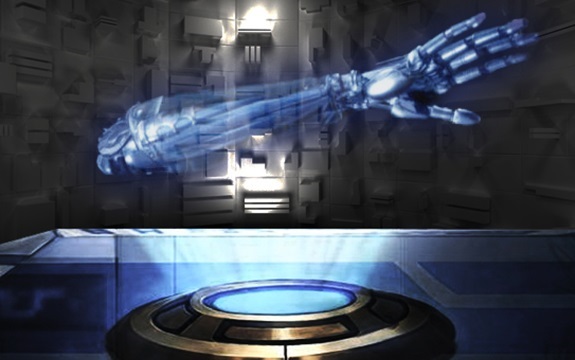4 November 2016
A case of being in the right place at the right time has enabled a longsought breakthrough in 3D technology that may soon make the holographic depictions of Star Wars’ R2D2 a reality.
It all started when Swinburne researcher Dr Xiangping Li’s work revealed the tiny refractive index of graphene in 2013. But it wasn’t until his group leader, Professor Min Gu, attended an optics conference in China later that year that they realised the implications of this research for 3D holographs.
The material’s tiny refractive index makes it possible to achieve a pixel size as small as 0.5 micrometre — somewhere between the size of a bacteria and a virus — when recording a hologram.
This property has many potential applications, but in China, Gu heard researchers from the Beijing Institute of Technology describe the challenge posed by pixel size for creating holographic images with a large viewing angle.
The Beijing group had been researching holograph technology for many years but had come up against the challenge of how to increase the viewing angle to create images that could be viewed without glasses or other external assistance. The viewing angle is a measure of the angular distance from viewing the hologram front-on to side-on before the image distorts.
“I asked them how they could increase the viewing angle and they talked about reducing the pixel size,” says Gu. “We realised, ‘Ah, we can do that now!’.
Digital holographic images have conventionally been produced using spatial modulators (SLMs) which can only produce pixels as small as 10 micrometres. Using femtosecond laser pulses to reduce graphene oxide without heat and taking advantage of the material’s newly discovered tiny refractive index, the team at Swinburne’s Centre for Micro-Photonics created high-resolution images with light-bending pixels 1/20th the size of SLMs.
The proportional relationship between the pixel size of a hologram and the viewing angle of the holographic image it creates, means that the Swinburne-developed technique expanded the image’s viewing angle from 10 degrees to 52 degrees without the need for glasses. Better still, the refractive index change created by reduced graphene oxide is consistent across the light spectrum meaning that full-colour images can be produced.
The initial static 3D images produced by the Swinburne team are very small — one centimetre — but Gu is confident that they will soon be able to engineer larger images The Beijing Institute of Technology group with which the Swinburne team collaborated on the 3D research was originally looking to increase the viewing angle for use in military technology. However, the generation of wide-angle 3D images using graphenebased objects, with their flexibility and unusual electronic and optical properties, may also enable floating images to be projected from phones, screens and wearable mobile devices such as watches. The futuristic technology in Minority Report could soon become reality.
While Gu has now moved to RMIT University, he maintains strong links with his former team at Swinburne.













